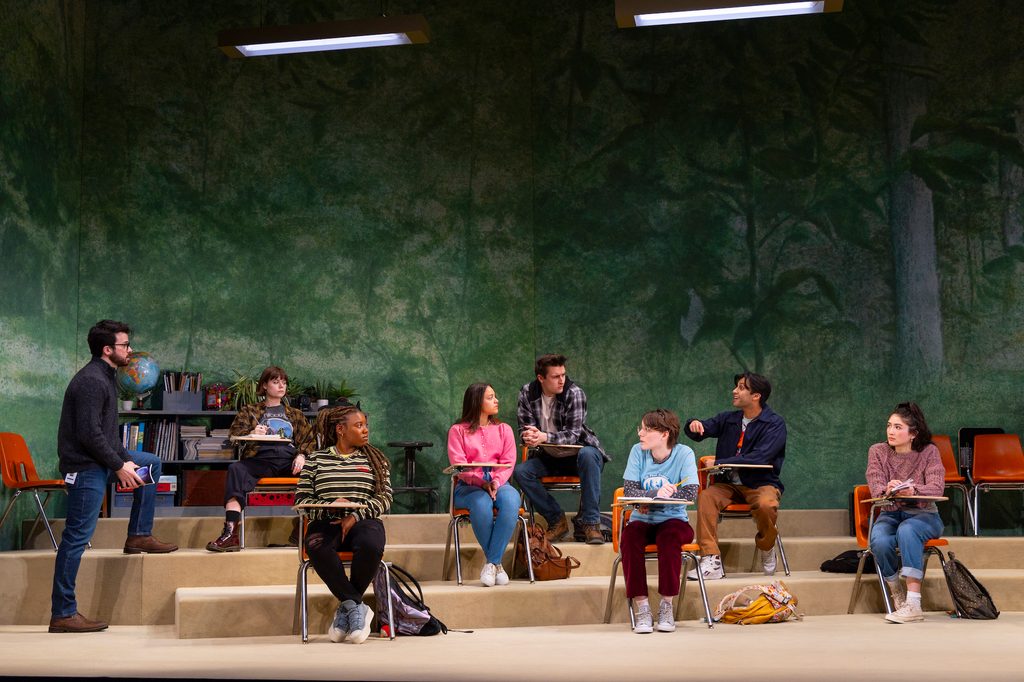
The Huntington presents ‘John Proctor is the Villain.’ Written by Kimberly Belflower. Directed by Margot Bordelon. Scenic Design by Kristen Robinson. Costume Design by Zoë Sundra. Lighting Design by Aja M. Jackson. Sound Design by Sinan Refik Zafar. At the BCA’s Calderwood Pavilion through March 10, 2024.
by Linda Chin
The Huntington’s provocative John Proctor is the Villain, by playwright Kimberly Belflower, is set in the present day, in a small – and small-minded – town in Appalachian Georgia. Four female students of diverse backgrounds, frustrated/inspired by discussions in their co-ed 11th grade Honors English/Sex-Education class centered on male heroes in The Crucible and scientific descriptions of sex, are eager to start a new ‘Feminism Club.’ Not surprisingly, the teenagers have different definitions of what “feminism” means and “feminists” are, different (and evolving) understandings of why it matters, and what the club’s purpose would be. The four young feminists are all on board to be the club’s founders, but will the School Board of the one-stoplight town give them the green light?
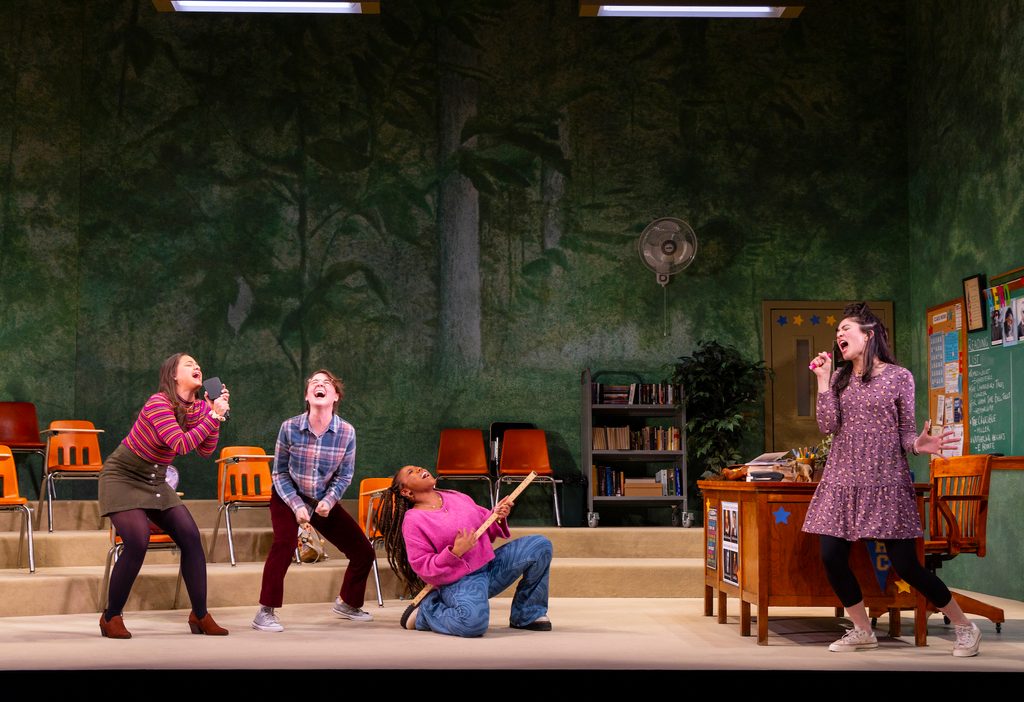
For Ivy (Brianna Martinez), who’s from old Southern money and has been hosting sleepovers at her house for years, it’d be fun to hang out with her pals and talk about the opposite sex – including the two cute but clueless guys in English class and their male teacher, who “btw” looks “hot” in tight sweatpants. Her best friend Beth (Jules Talbot), a straight-A student with a type-A personality, thinks the club would be a fabulous leadership cred for college applications and an opportunity to discuss strong female literary figures for a change. Raelynn (Haley Wong), the town preacher’s daughter, is also enthused about the idea, though her idea of great literature is the Twilight series. For Nell (Victoria Omoregie), a transfer student from Atlanta, it’d be a chance to ease the transition from big city to small town thinking, to feel more understood and less isolated, to break into the tight-knit group of girls who’ve known each other for most of their lives.
Beth, Ivy, Nell, and Rayleigh share the common desire to have a safe forum for discussion, a space where their voices would be heard, they could give and receive support, and they would feel seen and believed. Thinking they would have a kindred spirit in the new school counselor, Bailey Gallagher (Olivia Hebert), they become discouraged when she expresses her concern that parents and school officials might object and doesn’t immediately approve their plan. Serendipitously, their Honors English teacher, Carter Smith (Japhet Balaban), enters the scene and heroically saves the day. Not only does Smith offer to be the Club’s advisor, but he suggests adding curricular elements, e.g., discussions and dramatic readings of The Crucible, to the agenda to appease any skeptics. The girls do a happy dance and exit beaming – not only is Smith a teacher everyone respects, but a role model of feminist ideals!
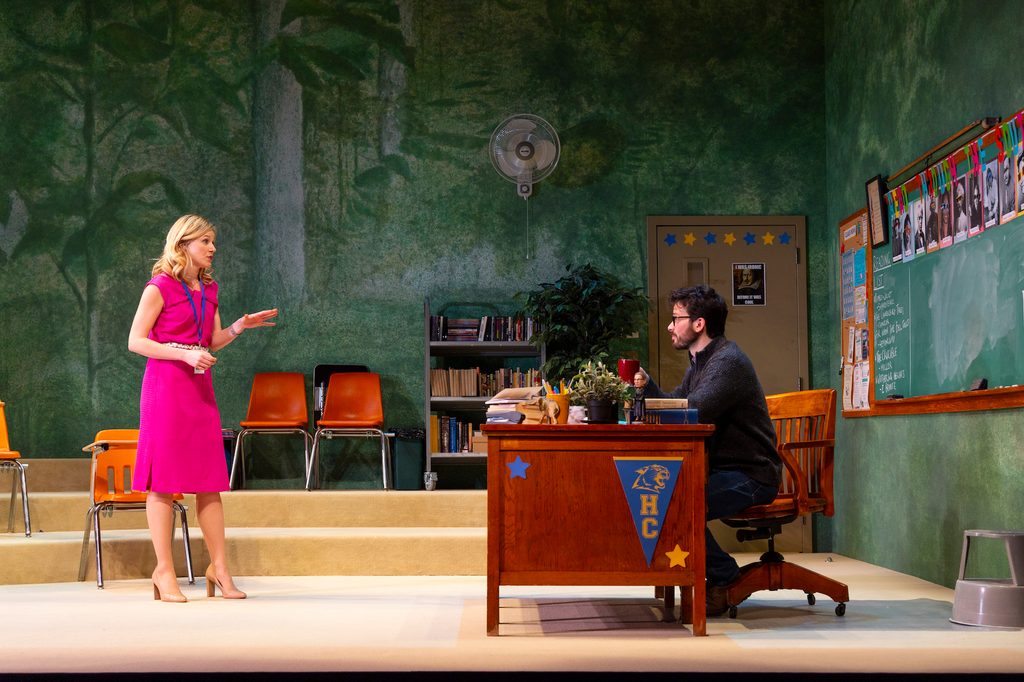
Even after the Club gets the green light, there are bumps in the road. Much to the young feminists’ dismay, Mr. Smith encourages one of the male athletes, Mason (Maanav Aryan Goyal), to participate in the club meetups to get extra credit. Male student Lee (Benjamin Izaak), Raelynn’s ex-boyfriend of seven years, tries to get back together but goes into a rage when she refuses, “like this isn’t you all this stuff you’re saying it’s like fuckin Beth and that new Atlanta girl and that club,” failing to understand that fucking her now ex-best friend prompted the breakup. Raelynn’s ex-best friend Shelby (Isabel Van Natta) reappears after a mysterious leave-of-absence and reveals that, no, she wasn’t pregnant with Lee’s baby, but she was sexually involved with older men in the community. Another scandal in town is that Ivy’s father is accused of sexual misconduct by a former employee. The students, both female and male, all coming-of-age, grapple with their feelings about who to trust, support, and listen to and their own desires to be heard, seen, believed, and loved.
In other productions of John Proctor is the Villain, including its world premiere at D.C.’s Studio Theatre, the play is presented in two distinct acts, two hours with an intermission. The Huntington’s production, directed by Margot Bordelon, has an approximate running time of 100 minutes with no intermission. Most of the action takes place on a unit set, a contemporary classroom with Mr. Smith’s power desk downstage left and student chairs with writing arms on three levels upstage (scenic design by Kristen Robinson). Lee sits on the top level, Ivy and Mason share the middle tier, and the other three female students are on the stage floor (the overachieving, teacher-pleasing Beth front and center, of course). While the seating formation made for an interesting stage picture (and may purposely have been arranged in a power pyramid), from my view of the stage, Mason was mostly eclipsed, and I wished he was on the top/bottom row instead.
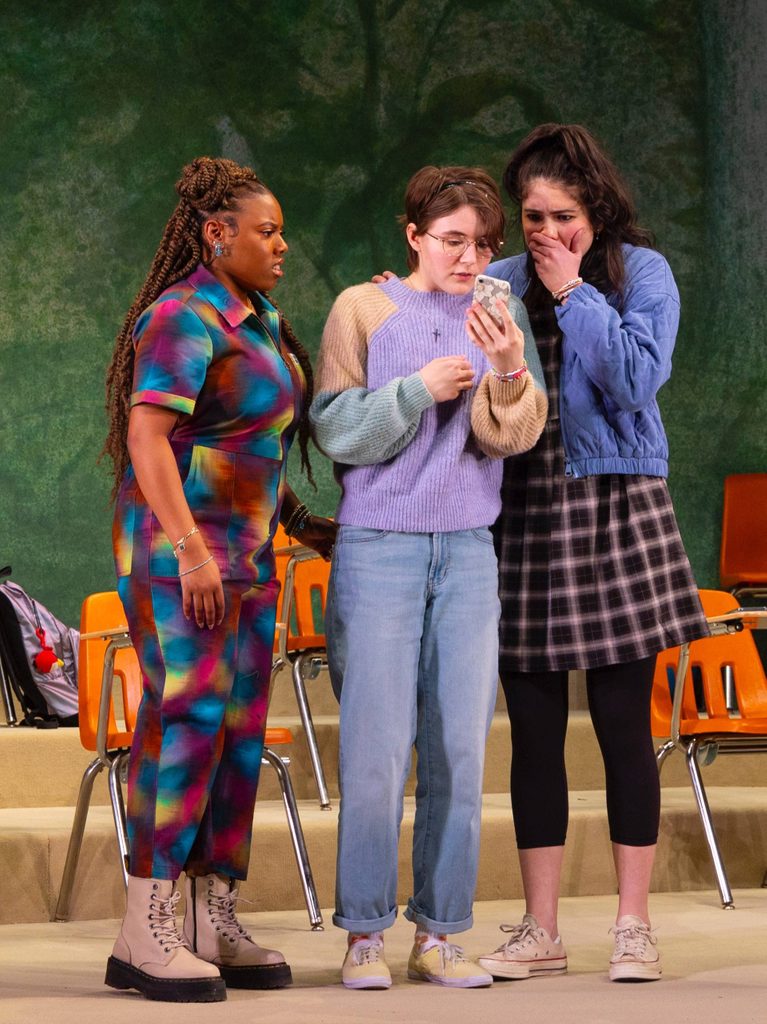
From the outset, John Proctor is the Villain starts out at a slow pace, the classroom dialogue is predictable, and the mean girls, horny boys vibe veered towards stereotypical. Not all the performers/students employed southern accents, but several who did were inconsistent. For scene changes, the stage lights went down, and pop music by Taylor Swift and Lizzo went up, reinforcing some of the themes about women and witch hunts, but at a more feverish pace (and higher volume) than the narrative called for (Sound Design by Sinan Refik Zafar).
Strong acting is the company’s strong suit, and as in most of The Huntington’s productions, John Proctor is the Villain featured strong performances across the board. Yet I felt disconnected from the world of the play much of the time because I was so conscious of the actors practicing their craft – not just during the play-within-a-play/characters’ dramatic readings of The Crucible in class, but overall. Despite their intelligent and perceptive performances, it didn’t feel believable for actors post-college age to play 16- and 17-year-old high school students; they didn’t read as minors. Similarly, the role of counselor Gallagher, who is in her first job out of school, ~24, was cast with an experienced, sophisticated actor who worked hard to play naïve. Still, adults’ age differences are less glaring. Thoughtful costume design by Zöe Sundra helped but didn’t completely resolve this casting conundrum.
For me (and my plus one, a high school senior), the play is more engaging towards the end; as the pacing picks up, the character development becomes clearer, and the actors’ performances are more natural and nuanced. Two scenes in particular were exceptional: Nell and Mason sitting on the floor during Feminism Club, collaborating on their special project, bridging differences across gender, race, and perspective, declaring that if problems arise, they’ll figure them out, and forming a supportive friendship that extends when they’re back in the classroom (and perhaps, if they both give each other the green light, may deepen outside school).
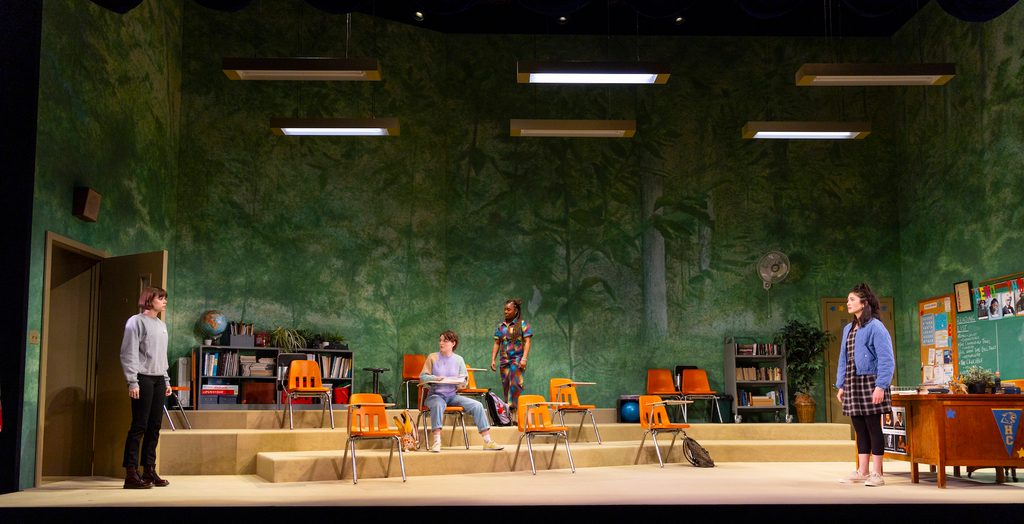
The second scene of note is close to the end of the play. After a stirring monologue, which concludes with Shelby leaving the classroom in shame, Raelynn runs out to lend her support and discovers her sitting alone on a bench. Raelynn asks if she can sit beside her, and Shelby consents. Against a backdrop of trees bathed in warm, green light (lighting design by Aja M. Jackson), the two young women help their friendship heal by talking it out (like teenage BFFs would likely do), making loud, guttural, snorty laughing sounds (like genteel southern women would likely not do), and then believing and forgiving each other, like the flawed, empathetic, humans – and feminists – they are.
John Proctor is the Villain closes with Raelynn and Shelby’s enactment of a scene – a conversation between two characters – from The Crucible that never took place, in this case, between Elizabeth Proctor and Abigail Williams. In Raelynn and Shelby’s contemporized version of the classic play, there are no innocent victims of a witch hunt who will be burned at the stake – or female figures who are gaslit – but feminists on fire. The two young women perform an interpretative dance to the song “Green Light” by Lorde that shows their rage and resilience; their classmates and counselor join in – and the audience jumps to their feet. End scene.
For tickets and information, go to: https://www.huntingtontheatre.org/

